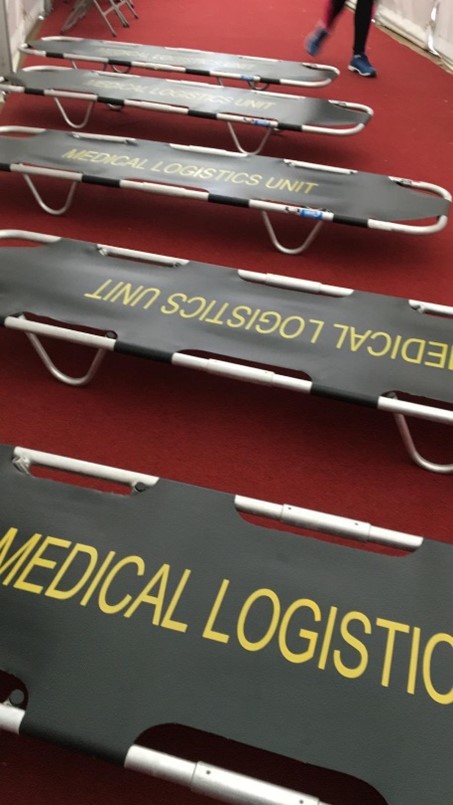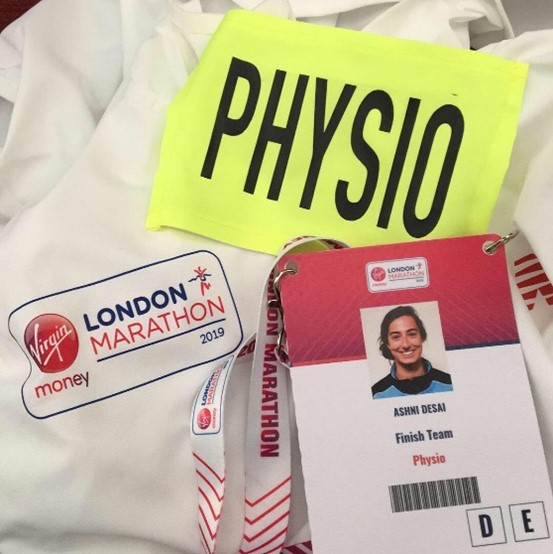After being issued with a band stating “physio”, I headed to the tent in which I would be based for the day.
There is a London Marathon Medical Tent at every mile, between which quad bikes rush up and down transporting casualties. Marathon runners can come to the tents, where they are triaged outside by St John Ambulance, and if appropriate, brought inside. Within the tents there are a couple of paramedics from St John Ambulance, physiotherapists and student podiatrists. There is also one doctor attached to the London Marathon Medical Team.
Stationed at last mile of the marathon and beyond the finish line, you will find those who are working as part of the ‘Finish Team’ within the official London Marathon Medical Team. This includes roughly 60 physiotherapists, some spread over the last mile and others divided into teams. One team is based right at the finish line, then the rest are spread across three teams based in ‘acute medical tents’ - I was based in one of these tents.
Two of these acute medical tents are located just past the finish line, on either side - beyond the van where runners collect their goodie bag (containing things such as salted pretzels, an apple, water and a foil blanket). The third acute medical tent is further down from there, at the Horse Guards Parade. In this tent, it is likely that some runners would be showing signs of physiological exhaustion.
At the opening of these medical tents are acute A&E facilities, with a mini ITU at the entrance and members from the helicopter team, as well as a consultant on standby. It is here, at the entrance, where runners are triaged by St John Doctors and specialist A&E nurses. There are two to three beds in critical care, one bed in the step down from ITU, and then approximately 10 army cots where the physiotherapists are based (see picture below) and some chairs where you would find student podiatrists. There is one more tent… set back in the royal quarters; this is only for the elite runners and the celebrities though!

As the runners started to come in, heavily fatigued and many in pain, the cots on the floor started filling.
The main conditions that I saw were: muscle cramps, stress fractures in the lower limb, blisters, dehydration, hyperthermia, exhaustion, muscle strains in the lower limb, sprained joints (e.g. ankles from rolling over on a bottle), knee pains, lacerations (e.g. from tripping over a barrier), overhydration, swollen feet, bleeding nipples (common in men), hyperventilating, people shivering, yet having a high temperature because they were in peripheral shut down or slight shock.
Muscle cramp was common and could have been occurring for different reasons; as a result of not having the sodium and potassium balance, or because the runner potentially had diarrhoea the day before the marathon (so they had therefore lost a lot of water and minerals), or because they drank too much water that day and hadn’t had enough salt (so we would make sure they started eating the salty pretzels from their goodie bags!).
It was therefore important to take a thorough medical history whilst you were doing some soft tissue treatment, in order to build a picture of how that runner’s last 3 weeks had been, their previous week and their last 24 hours.
Something that I didn’t see was exercise-associated hyponatremia (EAH). It was very important to watch out for the signs of this, such as sudden confusion, vomiting and headaches.
Other treatments on the day varied from soft tissue massage, passive stretching, suggesting rehydration powders, appropriately referring to hospital or podiatry, fluid replacement, providing ice bags and teaching breathing control techniques, often utilising a bag if someone was hyperventilating.
I was naive to think it would be a day of just sports massage with some nice portable physio beds; it was very much a day of thinking on your feet with people that could quickly deteriorate. However, morale was so high, both inside and outside of the tents, with cheering crowds filling the streets of London. There really is a buzz about the place, especially as people cross that line and celebrate their amazing achievement.
Written by Ashni Desai
See more information regarding the Loughborough University Physiotherapy Clinic.
